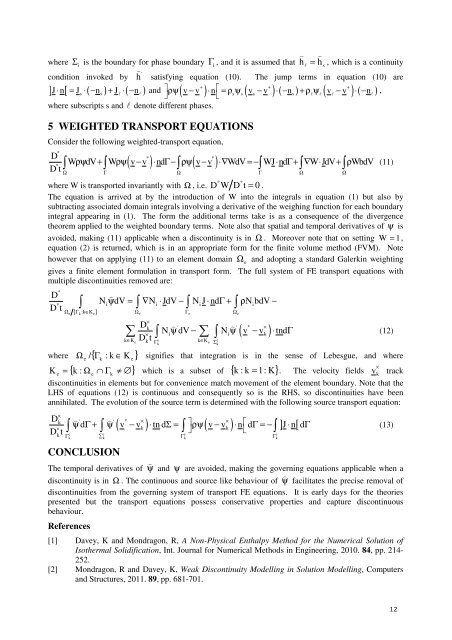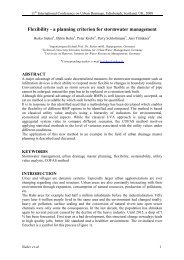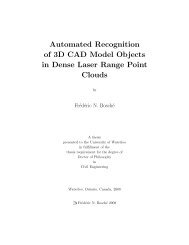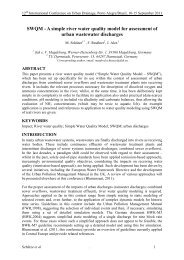ACME 2011 Proceedings of the 19 UK National Conference of the ...
ACME 2011 Proceedings of the 19 UK National Conference of the ...
ACME 2011 Proceedings of the 19 UK National Conference of the ...
Create successful ePaper yourself
Turn your PDF publications into a flip-book with our unique Google optimized e-Paper software.
where i Σ is <strong>the</strong> boundary for phase boundary i Γ , and it is assumed that h hs<br />
⌢<br />
⌢<br />
ℓ = , which is a continuity<br />
'<br />
h ⌢ satisfying equation (10). The jump terms in equation (10) are<br />
condition invoked by<br />
+ + +<br />
] J ⋅ n[ = Js ⋅( − ns ) + Jℓ ⋅( −n ℓ ) and ⎤ρψ ( v − v ) ⋅ n⎡ = ρsψs ( vs − v ) ⋅( − ns ) + ρ ψ ( vℓ − v ) ⋅( −nℓ<br />
⎦ ⎣ )<br />
where subscripts s and ℓ denote different phases.<br />
5 WEIGHTED TRANSPORT EQUATIONS<br />
Consider <strong>the</strong> following weighted-transport equation,<br />
* *<br />
( ) ( )<br />
ℓ ℓ ,<br />
*<br />
D<br />
Wρψ dV+ Wρψ v− v ⋅ndΓ− ρψ v− v ⋅∇ WdV = − WJ⋅ ndΓ+ ∇W⋅ JdV + ρWbdV<br />
*<br />
D t Ω Γ Ω Γ Ω Ω<br />
∫ ∫ ∫ ∫ ∫ ∫ (11)<br />
* *<br />
where W is transported invariantly with Ω , i.e. D W D t = 0 .<br />
The equation is arrived at by <strong>the</strong> introduction <strong>of</strong> W into <strong>the</strong> integrals in equation (1) but also by<br />
subtracting associated domain integrals involving a derivative <strong>of</strong> <strong>the</strong> weighing function for each boundary<br />
integral appearing in (1). The form <strong>the</strong> additional terms take is as a consequence <strong>of</strong> <strong>the</strong> divergence<br />
<strong>the</strong>orem applied to <strong>the</strong> weighted boundary terms. Note also that spatial and temporal derivatives <strong>of</strong> ψ is<br />
avoided, making (11) applicable when a discontinuity is in Ω . Moreover note that on setting W = 1,<br />
equation (2) is returned, which is in an appropriate form for <strong>the</strong> finite volume method (FVM). Note<br />
however that on applying (11) to an element domain Ω e and adopting a standard Galerkin weighting<br />
gives a finite element formulation in transport form. The full system <strong>of</strong> FE transport equations with<br />
multiple discontinuities removed are:<br />
D<br />
*<br />
⌢<br />
N ψ dV = ∇N ⋅JdV − N J ⋅ ndΓ + ρN bdV −<br />
∫ ∫ ∫ ∫<br />
*<br />
i i i i<br />
D t Ωe { Γk :k∈Ke }<br />
Ωe Γe Ωe<br />
D<br />
×<br />
k<br />
' '<br />
∑ × i i<br />
k K D e e<br />
e kt<br />
∫ ∑ ∫<br />
∈ Γ k∈K k<br />
e Σk<br />
* × ( k )<br />
⌢ ⌢<br />
N ψ dV − N ψ v − v ⋅ tndΓ<br />
where e / { Γk<br />
: k ∈ K e}<br />
K { k : Ω ∩ Γ ≠ ∅}<br />
which is a subset <strong>of</strong> { : k 1:<br />
K}<br />
Ω signifies that integration is in <strong>the</strong> sense <strong>of</strong> Lebesgue, and where<br />
e = e k<br />
(12)<br />
k = . The velocity fields k<br />
v× track<br />
discontinuities in elements but for convenience match movement <strong>of</strong> <strong>the</strong> element boundary. Note that <strong>the</strong><br />
LHS <strong>of</strong> equations (12) is continuous and consequently so is <strong>the</strong> RHS, so discontinuities have been<br />
annihilated. The evolution <strong>of</strong> <strong>the</strong> source term is determined with <strong>the</strong> following source transport equation:<br />
D<br />
D t<br />
⌢ ⌢<br />
* × ×<br />
( ) ⎤<br />
k ( k ) ⎡ ] [<br />
×<br />
k<br />
×<br />
k<br />
' '<br />
∫ ψ dΓ + ∫ ψ<br />
e e<br />
Γk ∑k v − v ⋅ tn dΣ = ∫ ρψ<br />
⎦ e<br />
Γk v − v ⋅ n dΓ = −<br />
⎣ ∫e<br />
Γk<br />
J ⋅n dΓ<br />
CONCLUSION<br />
The temporal derivatives <strong>of</strong> ψ ⌢ and ψ are avoided, making <strong>the</strong> governing equations applicable when a<br />
discontinuity is in Ω . The continuous and source like behaviour <strong>of</strong> ψ ⌢ facilitates <strong>the</strong> precise removal <strong>of</strong><br />
discontinuities from <strong>the</strong> governing system <strong>of</strong> transport FE equations. It is early days for <strong>the</strong> <strong>the</strong>ories<br />
presented but <strong>the</strong> transport equations possess conservative properties and capture discontinuous<br />
behaviour.<br />
References<br />
[1] Davey, K and Mondragon, R, A Non-Physical Enthalpy Method for <strong>the</strong> Numerical Solution <strong>of</strong><br />
Iso<strong>the</strong>rmal Solidification, Int. Journal for Numerical Methods in Engineering, 2010. 84, pp. 214-<br />
252.<br />
[2] Mondragon, R and Davey, K, Weak Discontinuity Modelling in Solution Modelling, Computers<br />
and Structures, <strong>2011</strong>. 89, pp. 681-701.<br />
(13)<br />
12













